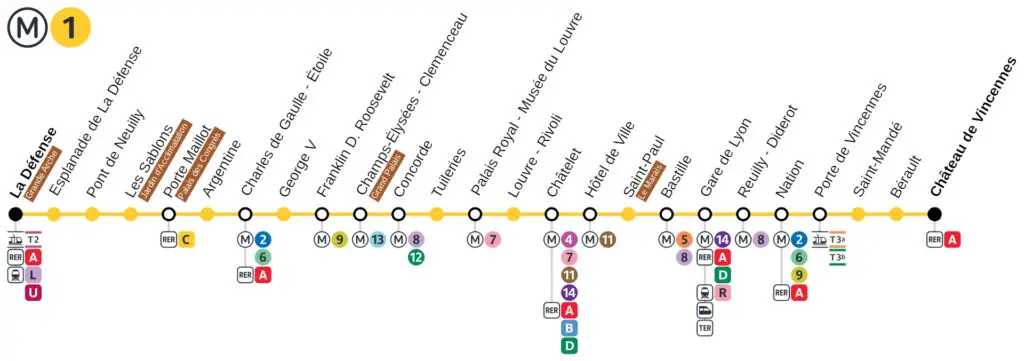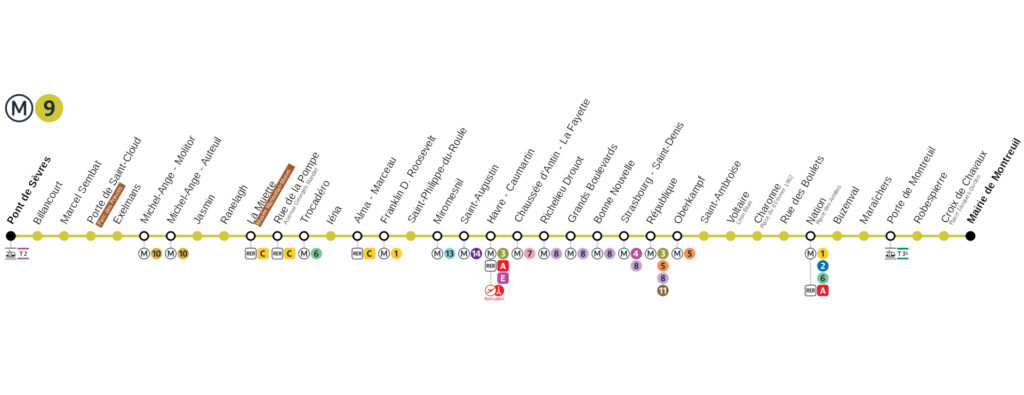Franklin D. Roosevelt
City
Paris
Metro lines
1 / 9
Franklin D. Roosevelt metro station
Franklin D. Roosevelt station is a metro station in Paris, France. It is on line 1 of the Paris metro, which connects the La Défense – Grande Arche and Château de Vincennes stations.
Franklin D. Roosevelt station is named in honor of Franklin Delano Roosevelt, the 32nd President of the United States. It is close to many of Paris’s most famous landmarks and tourist attractions, such as Avenue des Champs-Élysées and Avenue Montaigne, renowned for their luxury boutiques. It also offers convenient access to sites such as the Grand Palais and Petit Palais, home to art exhibitions and cultural events.
Franklin D. Roosevelt station is a transfer point for line 9 of the Paris metro, making it easy to get to other parts of the city. It is also served by several bus lines, making it easy for travelers to get around the French capital.
The platforms on both lines have a standard configuration: two per stop, separated by the tracks in the center, with an elliptical vault. What sets them apart, however, is their cultural layout, which itself differs between the two lines.
The station has seven entrances.
Inauguration of the station
Franklin D. Roosevelt station was inaugurated on June 13, 1900. It was one of the first stations on line 1 of the Paris metro, then known as the “Chemin de fer métropolitain de Paris”. Since its opening, the station has been modernized and renovated several times to meet the growing needs of passengers and current safety standards.
Where does the name come from ?
Franklin D. Roosevelt station takes its name from Franklin Delano Roosevelt, who was the 32nd President of the United States. The choice of this name pays tribute to Roosevelt in recognition of his role in the Second World War and his support for France during that period.
Franklin D. Roosevelt, often abbreviated FDR, was President of the United States from 1933 to 1945. He played a major role in fighting the Great Depression and led the United States through much of the Second World War, until his death in 1945. Roosevelt was known for his leadership and his New Deal policy, which aimed to stimulate the American economy and provide assistance to citizens affected by the economic crisis.
The choice of naming a Paris metro station after Roosevelt reflects the historic relationship between France and the United States, as well as admiration for Roosevelt’s leadership during critical periods of world history.
Where to go from Franklin D. Roosevelt ?
From Franklin D. Roosevelt station, located on line 1 of the Paris metro, you can get to many of Paris’ popular places using public transport. Here are a few suggestions:
- Champs-Élysées : Get off at the Charles de Gaulle – Étoile station, which is just two stops from Franklin D. Roosevelt. From here, you can access the Champs-Élysées avenue, famous for its stores, restaurants and tourist attractions.
- Louvre: Take line 1 towards Château de Vincennes to the Palais Royal – Musée du Louvre station. This station provides access to the famous Musée du Louvre and the surrounding area.
- Eiffel Tower: Get off at Trocadéro station, just a few stops from Franklin D. Roosevelt. From here, you can enjoy breathtaking views of the Eiffel Tower and stroll through the Trocadero gardens.
- Marais district: Take line 1 towards Château de Vincennes to Hôtel de Ville station. This historic district of Paris is known for its picturesque alleyways, trendy boutiques and numerous museums.
- Opéra Garnier: Get off at Opéra station, just a few stops from Franklin D. Roosevelt. You can discover the Opéra Garnier, a magnificent 19th-century building, and enjoy the stores and restaurants in the area.
These are just a few suggestions, but line 1 of the Paris metro offers many other ways to get to other parts of the city and its attractions.
Many public transport lines pass through this metro station: metros 1 and 9, RATP buses 28, 32, 42, 73, 80 and 93.
What’s nearby ?
Franklin D. Roosevelt station is located in a lively area of Paris, offering convenient access to many attractions and points of interest. Here are just a few of the landmarks located near this station:
- Avenue des Champs-Élysées : Franklin D. Roosevelt station is one of the closest stations to Avenue des Champs-Élysées, one of the most famous and prestigious avenues in Paris. You’ll find many luxury stores, restaurants, cafés and cinemas along this avenue.
- Avenue Montaigne: This avenue adjacent to the Champs-Élysées is renowned for its high-end fashion boutiques, couture houses and jewelry shops. Here you can discover the latest trends in Parisian fashion and elegance.
- Grand Palais and Petit Palais: These two magnificent buildings are located near the Franklin D. Roosevelt station. The Grand Palais hosts temporary exhibitions, salons and cultural events, while the Petit Palais houses the Musée des Beaux-Arts de la Ville de Paris, with its collection of Impressionist and modern art.
- Théâtre des Champs-Élysées: Located just a few steps from the station, this theater is a prestigious venue for opera, ballet and concert performances. It is renowned for its Art Nouveau architecture and varied cultural program.
- Pont de l’Alma: This bridge across the Seine is located near Franklin D. Roosevelt station. It offers panoramic views of the Eiffel Tower, and is also a symbolic site for the Mémorial de la Flamme de l’Alma, dedicated to the memory of Lady Diana.
These attractions and places are just a taste of what you can find near Franklin D. Roosevelt station. The area is full of restaurants, cafés, boutiques and other interesting sites to explore.
Anecdotes
- It was in this station that Hervé Vilard, then an 18-year-old orphan, saw a poster advertising “Partez en vacances à Capri !” (Go on vacation to Capri!). It was a great inspiration to him. He immediately went back to his maid’s room to compose the melody and write the lyrics in 7 minutes. “Capri c’est fini” went on to become an international hit, his 2nd biggest success after Nous (1979).
- An entrance to the station can be seen in a scene from Albert Dupontel’s film Au revoir là-haut (2017), set in 1919. The original Guimard aedicule is reconstructed here, although this is a slight anachronism, as the CMP had in fact removed it as early as 1908.

